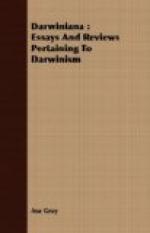XI-1. “Insectivorous Plants. By Charles Darwin, M.A., F.R.S.” With Illustrations. London: John Murray. 1875. Pp. 462. New York: D. Appleton & Co.
“The Movements and Habits of Climbing Plants. By Charles Darwin, M.A., F.R.S., etc.” Second Edition, revised, with Illustrations. London: John Murray. 1875. Pp. 208. New York: D. Appleton & Co.
XI-2. The Nation, Nos. 457, 458, 1874. It was in these somewhat light and desultory, but substantially serious, articles that some account of Mr. Darwin’s observations upon the digestive powers of Drosera and Dionaea first appeared; in fact, their leading motive was to make sufficient reference to his then unpublished discoveries to guard against expected or possible claims to priority. Dr. Burdon-Sanderson’s lecture, and the report in Nature, which first made them known in England, appeared later.
A mistake on our part in the reading of a somewhat ambiguous sentence in a letter led to the remark, at the close of the first of those articles, that the leaf-trap of Dionaea had been paralyzed on one side in consequence of a dexterous puncture. What was communicated really related to Drosera.
XI-3. A. Gray, in “Proceedings of the American Academy of Arts and Sciences,” vol. iv., p. 98; and American Journal of Science and the Arts, March, 1859, p. 278.
XII-1. “Les Especes affines et la Theorie de l’Evolution,” par Charles Naudin, Membre de l’Institut, in Bulletin de la Societe Botanique de France, tome xxi., pp. 240-272, 1874. See also Comptes Rendus, September 27 and October 4, 1875, reproduced in “Annales des Sciences Naturelles,” 1876, pp. 73-81.
XII-2. In noticing M. Naudin’s paper in the Comptes Rendus, now reprinted in the “Annales des Sciences Naturelles,” entitled “Variation desordonnee des Plantes Hybrides et Deductions qu’on peut en tirer,” we were at a loss to conceive why he attributed all present variation of species to atavism, i.e., to the reappearance of ancestral characters (American Journal of Science, February, 1876). His anterior paper was not then known to us; from which it now appears that this view comes in as a part of the hypothesis of extreme plasticity and variability at the first, subsiding at length into entire fixity and persistence of character. According to which, it is assumed that the species of our time have lost all power of original variation, but can still reproduce some old ones—some reminiscences, as it were, of youthful vagaries—in the way of atavism.
XIII-1. London, 1862.
XIII-2. Hume, in his “Essays,” anticipated this argument. But he did not rest on it. His matured convictions appear to be expressed in statements such as the following, here cited at second hand from Jackson’s “Philosophy of Natural Theology,” a volume to which a friend has just called our attention:




